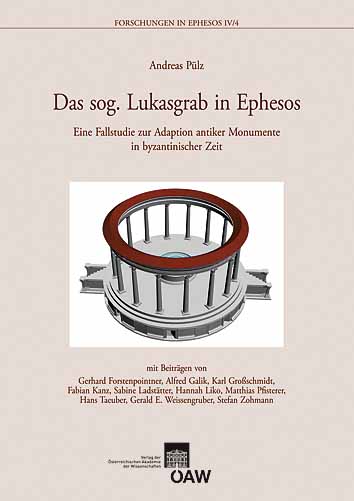


Das erstmals im 19. Jahrhundert
untersuchte Lukasgrab südöstlich
des Staatsmarktes von Ephesos
wurde wegen eines kaiserzeitlichen
Reliefs mit der Darstellung
eines Zebus samt sekundär eingetieftem
Kreuz über dem Buckel
des Tieres zunächst als Grabanlage
des Evangelisten bezeichnet.
Aufgrund weiterer Forschungen
wurde schließlich eine Interpretation
als römisches Heroon oder als Tempel favorisiert,
der in frühbyzantinischer Zeit zu einer Kirche umfunktioniert
worden sein soll. Dieses Bild ist allerdings nach den
Untersuchungen der Jahre 1997 bis 2004 großteils zu
revidieren. Bei dem Rundbau handelt es sich vielmehr um
eine Brunnenanlage, die im 2. Jahrhundert nach Christus
inmitten eines von Säulenhallen eingefassten Marktplatzes
errichtet worden ist.
Gedruckt mit Unterstützung des Fonds zur Förderung der wissenschaftlichen Forschung (FWF).

…
The so-called tomb of St. Luke that is
situated to the southeast of the State
Agora of Ephesus was investigated
for the first time in the 19th century.
Because of a relief from the Roman Imperial period showing a zebu with a secondary
engraved cross above its hump, the monument was
initially called the tomb of the evangelist. Further
examinations led to it being interpreted as a Roman
heroon that in early Byzantine times was then rebuilt
as a church. Due to the results of new investigations
undertaken since 1997, this picture has had to be revised.
In fact, the rotunda has turned out to be a fountain
from the Roman Imperial period, which was erected in
the centre of a marketplace surrounded by columned
halls. In the 5th century, the fountain was adapted to
accommodate a church. Several architectural clues point
to it having been commemorative church, and it possibly
played an important role in Ephesus as a pilgrimage site.
This study summarizes the results of new investigations
undertaken by the author from 1997 to 2004, with special
attention being paid to the Imperial-period monument
as well as its later use, including its various stages of
remodelling and decorating.
The sometimes complex findings are elucidated through
a large number of photographs and drawings. The
volume also includes contextual analyses of the findings,
which were conducted by S. Ladstätter and H. Liko
(ceramics), M. Pfisterer (numismatics), K. Großschmidt
and F. Kanz (anthropology), H. Taeuber (epigraphy)
and G. Forstenpointner, A. Galik, G. E. Weissengruber
and S. Zohmann (archaeozoology).
Printed with the support of the Austrian Sciences Fund (FWF)
2010,
978-3-7001-6555-2
978-3-7001-6988-8
641 Seiten, 224 Tafeln,
29,7x21cm, broschiert